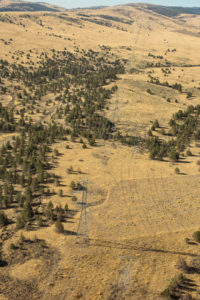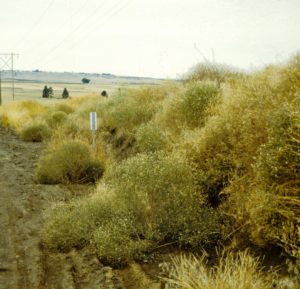Local News
Flyover examines BPA corridor

The Bonneville Power Administration, Warm Springs Natural Resources and Wasco County representatives did a flyover of the BPA transmission lines on the reservation earlier this month. Through an agreement with the tribe, BPA transports electrical power through the reservation via high voltage transmission lines. There are several miles of transmission lines on the northern part of the reservation.
The purpose of the flyover was to look at vegetation management efforts, and work to control noxious weed growth. BPA’s work ensures that there is no physical contact between the transmission lines and nearby vegetation. They also control noxious weeds in the corridor. BPA conducts several flyovers annually of the transmission corridors.
Noxious weeds are defined as a weed that has a negative impact on the ecosystem, livestock and/or humans. Many of the weeds have been introduced into the ecosystem by humans, whether on purpose or by accident. Noxious weeds can overtake areas and compete with important tribal resources including timber, livestock, and traditional foods like huckleberry bushes.
From the air, noxious plants like Scotch broom can be spotted. Scotch broom is a shrub native to Europe, and while beautiful with its yellow flowers, is classified as a noxious plant because it competes with native plants and is difficult to remove. This woody scrub can grow up to 10 feet tall and has been found in transmission corridors on the reservation. The cost of Scotch broom is significant—the Oregon Department of Agriculture estimated that this invasive weed results in the loss of $47 million dollars annually in timber production. Wasco County is currently contracted by BPA to manage noxious weeds along reservation transmission corridors.

Warm Springs Natural Resources has on on-going effort to manage noxious weeds on the reservation. These efforts include surveying along roadways and utility rights of ways for weeds such as yellow star thistle, medusahead, various types of knapweed, cheat grass and puncturevine. Local removal efforts include application of herbicides and biocontrol efforts (use of bugs) that target specific plants.
Over the summer, surveys were conducted along reservation roads and utility right of ways to identify and remove noxious weeds. Along Highway 26, survey efforts identified yellow star thistle, a weed that causes “chewing disease” in horses affecting the nervous system and possibly resulting in death. Community members are probably familiar with knapweed as it grows into large tumbleweeds.
Natural Resources has information available to help identify noxious weeds and tips for removing these invasive plants. Early detection and response is key to controlling noxious weed growth, and the community is a key partner in this success.
